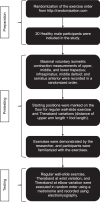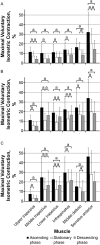Theraband Applications for Improved Upper Extremity Wall-Slide Exercises
- PMID: 36356616
- PMCID: PMC9661929
- DOI: 10.4085/1062-6050-0305.21
Theraband Applications for Improved Upper Extremity Wall-Slide Exercises
Abstract
Context: The wall-slide exercise is commonly used in clinic and research settings. Theraband positioning variations for hip exercises have been investigated and used, but Theraband positioning variations for upper extremity wall-slide exercises, although not commonly used, have not been examined.
Objective: To evaluate the effect of different Theraband positions (elbow and wrist) on the activation of the scapular and shoulder muscles in wall-slide exercises and compare these variations with each other and with regular wall-slide exercises for the upper limbs.
Design: Descriptive laboratory study.
Setting: University laboratory.
Patients or other participants: A total of 20 participants (age = 23.8 ± 3 years, height = 176.5 ± 8.14 cm, mass = 75.3 ± 12.03 kg, body mass index = 24.23 ± 4.03) with healthy shoulders.
Intervention(s): Participants performed wall-slide exercises (regular and 2 variations: Theraband at the elbow and Theraband at the wrist) in randomized order.
Main outcome measure(s): Surface electromyographic activity of the trapezius (upper trapezius [UT], middle trapezius [MT], and lower trapezius [LT]), infraspinatus, middle deltoid (MD), and serratus anterior (SA) muscles.
Results: Regular wall-slide exercises elicited low activity in the MD and moderate activity in the SA muscles (32% of maximal voluntary isometric contraction [MVIC] in the SA), whereas the Theraband-at-elbow and Theraband-at-wrist variations elicited low activity in the MT, LT, infraspinatus, and MD muscles and moderate activity in the SA muscle (46% and 34% of MVIC in the SA, respectively). The UT activation was absent to minimal (classified as 0% to 15% of MVIC) in all wall-slide exercise variations. The Theraband-at-wrist variation produced lower UT:MT, UT:LT, and UT:SA levels compared with the regular wall-slide exercise and Theraband-at-elbow variation.
Conclusions: In shoulder rehabilitation, clinicians desiring to activate the scapular stabilization muscles should consider using the Theraband-at-wrist variation. Those seeking more shoulder-abduction activation and less scapular stabilization should consider using the Theraband-at-elbow variation of the upper extremity wall-slide exercise.
Keywords: electromyography; exercise therapy; rehabilitation; shoulder; superficial back muscles.
© by the National Athletic Trainers' Association, Inc.
Figures




Similar articles
-
Optimal activation ratio of the scapular muscles in closed kinetic chain shoulder exercises: A systematic review.J Back Musculoskelet Rehabil. 2021;34(1):3-16. doi: 10.3233/BMR-191771. J Back Musculoskelet Rehabil. 2021. PMID: 32831190
-
Scapular muscle-activation ratios in patients with shoulder injuries during functional shoulder exercises.J Athl Train. 2014 May-Jun;49(3):345-55. doi: 10.4085/1062-6050-49.3.10. Epub 2014 May 19. J Athl Train. 2014. PMID: 24840585 Free PMC article. Clinical Trial.
-
Analysis of Scapular Kinematics and Muscle Activity by Use of Fine-Wire Electrodes During Shoulder Exercises.Am J Sports Med. 2020 Apr;48(5):1213-1219. doi: 10.1177/0363546520908604. Epub 2020 Mar 16. Am J Sports Med. 2020. PMID: 32176519
-
Incorporation of the Kinetic Chain Into Shoulder-Elevation Exercises: Does It Affect Scapular Muscle Activity?J Athl Train. 2020 Apr;55(4):343-349. doi: 10.4085/1062-6050-136-19. Epub 2020 Mar 11. J Athl Train. 2020. PMID: 32160060 Free PMC article.
-
Muscle Activity Ratios of Scapular Stabilizers During Closed Kinetic Chain Exercises in Healthy Shoulders: A Systematic Review.J Sport Rehabil. 2019 Dec 19;29(7):1001-1018. doi: 10.1123/jsr.2018-0449. Print 2020 Sep 1. J Sport Rehabil. 2019. PMID: 31860828
Cited by
-
Investigation of muscle activation during kinetic chain based exercises in individuals with and without forward head posture.J Back Musculoskelet Rehabil. 2024;37(6):1537-1549. doi: 10.3233/BMR-230397. J Back Musculoskelet Rehabil. 2024. PMID: 38968043 Free PMC article.
References
Publication types
MeSH terms
LinkOut - more resources
Full Text Sources
Medical

